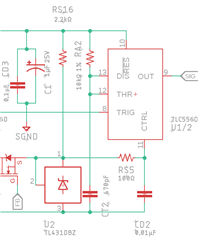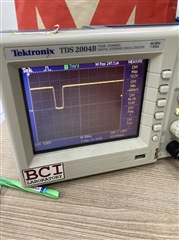Other Parts Discussed in Thread: LMC555, TLC555
Dear TI E2E Support Team,
Our current project involves implementing the TLC556 dual CMOS timers IC. Specifically, we've encountered an issue with one of the timers configured as a monostable circuit. This timer, supplied with 12 V power and a control voltage of 2.5 V on its CONT pin, is triggered by pulse signals to its TRIG, as illustrated in the accompanying figure.

However, we've observed that this monostable timer fails to respond to the triggering signal. No waveform is detectable from either the timer's DISCH or OUT pins. The characteristics of our TRIG signal include a pulse width of about 100 ns and a frequency of approximately 80 kHz, as depicted in the figure.

Through trial and error, we experimented by using a 500 ns TRIG pulse width instead of 100 ns, resulting in the detection of the expected waveform from the DISCH and OUT pins. Our suspicion is that the 100 ns TRIG pulse width might be insufficient to trigger the timer. While we acknowledge that CMOS timers typically require minimal pulse duration—such as the LMC555, which specifies a 20 ns TRIG pulse width—we understand that the TLC556 might differ in its operational requirements. Unfortunately, we couldn't locate information regarding the minimum TRIG pulse width for the TLC556 (and TLC555) in their datasheets.
Therefore, we need your help in understanding why a 100 ns pulse width might not work and determining the TLC556's minimum TRIG pulse width for stable triggering. Our application requires a very short output pulse width, just slightly longer than 1 microsecond. We aim to minimize the TRIG pulse width to prevent unintended re-triggering. Additionally, any insights into other potential causes of this issue would be greatly appreciated.
Best Regards,
Thiwat Udomlertsirikul


